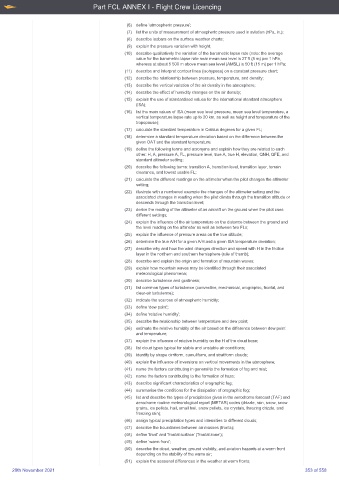Page 353 - UK Aircrew Regulations (Consolidated) 201121
P. 353
Part FCL ANNEX I - Flight Crew Licencing
(6) define ‘atmospheric pressure’;
(7) list the units of measurement of atmospheric pressure used in aviation (hPa, in.);
(8) describe isobars on the surface weather charts;
(9) explain the pressure variation with height;
(10) describe qualitatively the variation of the barometric lapse rate (note: the average
value for the barometric lapse rate near mean sea level is 27 ft (8 m) per 1 hPa,
whereas at about 5 500 m above mean sea level (AMSL) is 50 ft (15 m) per 1 hPa;
(11) describe and interpret contour lines (isohypses) on a constant pressure chart;
(12) describe the relationship between pressure, temperature, and density;
(13) describe the vertical variation of the air density in the atmosphere;
(14) describe the effect of humidity changes on the air density;
(15) explain the use of standardised values for the international standard atmosphere
(ISA);
(16) list the main values of ISA (mean sea level pressure, mean sea level temperature, a
vertical temperature lapse rate up to 20 km, as well as height and temperature of the
tropopause);
(17) calculate the standard temperature in Celsius degrees for a given FL;
(18) determine a standard temperature deviation based on the difference between the
given OAT and the standard temperature;
(19) define the following terms and acronyms and explain how they are related to each
other: H, A, pressure A, FL, pressure level, true A, true H, elevation, QNH, QFE, and
standard altimeter setting;
(20) describe the following terms: transition A, transition level, transition layer, terrain
clearance, and lowest usable FL;
(21) calculate the different readings on the altimeter when the pilot changes the altimeter
setting;
(22) illustrate with a numbered example the changes of the altimeter setting and the
associated changes in reading when the pilot climbs through the transition altitude or
descends through the transition level;
(23) derive the reading of the altimeter of an aircraft on the ground when the pilot uses
different settings;
(24) explain the influence of the air temperature on the distance between the ground and
the level reading on the altimeter as well as between two FLs;
(25) explain the influence of pressure areas on the true altitude;
(26) determine the true A/H for a given A/H and a given ISA temperature deviation;
(27) describe why and how the wind changes direction and speed with H in the friction
layer in the northern and southern hemisphere (rule of thumb);
(28) describe and explain the origin and formation of mountain waves;
(29) explain how mountain waves may be identified through their associated
meteorological phenomena;
(30) describe turbulence and gustiness;
(31) list common types of turbulence (convective, mechanical, orographic, frontal, and
clear-air turbulence);
(32) indicate the sources of atmospheric humidity;
(33) define ‘dew point’;
(34) define ‘relative humidity’;
(35) describe the relationship between temperature and dew point;
(36) estimate the relative humidity of the air based on the difference between dew point
and temperature;
(37) explain the influence of relative humidity on the H of the cloud base;
(38) list cloud types typical for stable and unstable air conditions;
(39) identify by shape cirriform, cumuliform, and stratiform clouds;
(40) explain the influence of inversions on vertical movements in the atmosphere;
(41) name the factors contributing in general to the formation of fog and mist;
(42) name the factors contributing to the formation of haze;
(43) describe significant characteristics of orographic fog;
(44) summarise the conditions for the dissipation of orographic fog;
(45) list and describe the types of precipitation given in the aerodrome forecast (TAF) and
aerodrome routine meteorological report (METAR) codes (drizzle, rain, snow, snow
grains, ice pellets, hail, small hail, snow pellets, ice crystals, freezing drizzle, and
freezing rain);
(46) assign typical precipitation types and intensities to different clouds;
(47) describe the boundaries between air masses (fronts);
(48) define ‘front’ and ‘frontal surface’ (‘frontal zone’);
(49) define ‘warm front’;
(50) describe the cloud, weather, ground visibility, and aviation hazards at a warm front
depending on the stability of the warm air;
(51) explain the seasonal differences in the weather at warm fronts;
20th November 2021 353 of 558

